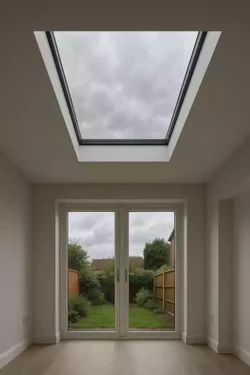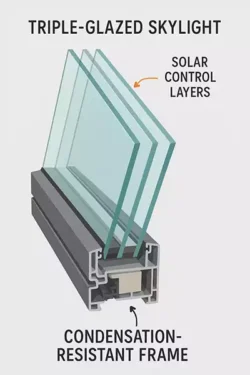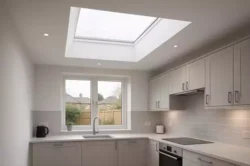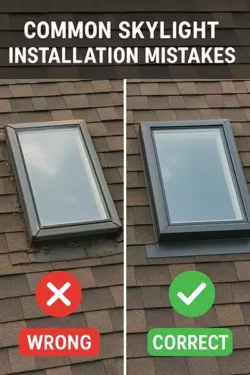

Many homeowners love the idea of bringing more natural light into their living spaces—but when cloudy skies and frequent rainfall are the norm, you may ask: Are skylights worth it in the UK climate? This in-depth guide examines how skylights (rooflights) perform in British weather, explores SM Glass Tech’s offerings, and helps you make an informed, practical decision for your home or office.
The UK’s climate is classified as temperate oceanic, defined by cloudy skies, mild temperature ranges, and abundant rain—especially in the west and north.
Despite this, even diffuse daylight from overcast skies can significantly brighten interior spaces. As the U.S. Department of Energy notes, toplighting through skylights can be three to ten times more effective than sidelighting via vertical windows.
SM Glass Tech specialises in premium rooflights engineered to maximise light while minimising framework—ideal for any renovation or new-build in the UK. Their product range includes:
These rooflights are designed for performance, durability, and style—enhancing brightness, ventilation, and spatial perception while fitting seamlessly into roofs of all pitches.
Despite its reputation for cloudiness and rain, the UK climate offers clear advantages for installing well-specified skylights:
Even under grey skies, skylights bring in three to ten times more daylight than side windows. In areas like north-facing rooms, small kitchens, corridors, conservatories, and lofts, skylights flood spaces with light where wall windows can’t reach.
High-performance glazing with low U-values (e.g. ≤1.6 W/m²K) helps retain indoor heat during winter, while solar control glass mitigates summer overheating. SM Glass Tech offers insulated glass units and coatings that reduce heat transfer while maximising visible light.
According to The Eco Experts, effective rooflights can save up to £195 per year on energy bills in British homes.
Ventilated roof windows are ideal for kitchens, bathrooms, and loft conversions—helping to reduce mould, damp, and condensation. Some models in SM Glass Tech’s range offer rain‑sensitive or automated opening features.
Natural light has strong psychological benefits—boosting mood, alertness, and general well-being. Skylights also make interiors feel larger and lift property appeal. SM Glass Tech’s rooflights are increasingly popular in extensions and loft conversions across London.

That said, skylights in the UK climate come with potential drawbacks—each manageable with proper planning and specification.
To avoid these issues, always choose:
Given frequent British rain, skylight leaks remain a risk.
During short winter days, natural light may still be limited. South- or east-facing rooflights typically receive more daylight year-round.
Supplementing with artificial lighting may be necessary in very dim areas.
Here’s a curated breakdown of SM Glass Tech’s rooflight types, highlighting their suitability for UK homes:
All include energy-efficient IGUs, solar coatings, and compliant flashing—designed to withstand UK weather with minimal upkeep.

Ideal skylights in the UK have a U-value of 1.6 W/m²K or lower, which reduces heating losses and increases comfort. Quality IGUs with gas fill, thermal spacers, and Low‑E coatings help meet this standard.
Balancing solar gain is crucial:
Opening or vented rooflights improve ventilation, particularly in kitchens or bathrooms. They help avoid condensation buildup and improve air quality.
Recommended Maintenance:
SM Glass Tech recommends quality rooflights engineered for durability, alongside installers who use correct installation practices.
SM Glass Tech has completed numerous installations across London and the south-east:
These installations demonstrate skylight effectiveness even in dense urban areas subject to shading and limited roof space.

| Benefit | Implication in UK Climate |
|---|---|
| High daylight even on overcast days | Effective toplighting significantly brightens interiors |
| Energy savings in winter | Low U‑value glazing retains heat efficiently |
| Improved ventilation and air quality | Vented models prevent moisture and mould |
| Increased property appeal | Creates spacious, modern interiors buyers love |
| Potential heat loss or gain | Mitigated with solar control glass and insulation |
| Risk of leaks or condensation | Avoided with professional installation and quality flashing |
When planning to enhance natural light, many homeowners weigh the benefits of skylights versus traditional vertical windows. While both bring sunlight indoors, their performance and impact vary greatly depending on room layout, climate, and intended usage—especially in the UK’s overcast weather.
Traditional side windows are the most common form of daylighting and ventilation. They’re simple to install, offer broad visibility, and are typically more accessible for operation and cleaning. In Victorian and post-war homes across the UK, vertical windows dominate—especially in bedrooms, lounges, and kitchens.
These issues are especially apparent in north-facing rooms or ground-floor rear extensions—areas where sunlight is scarce during winter.
more: best custom skylights
By contrast, skylights offer top-down lighting, which is significantly more effective in reaching the middle of a room. On cloudy days (which are common in the UK), even diffuse daylight from above can make a significant difference to perceived brightness and mood.
Consider a common renovation in places like London—a single-storey kitchen extension with bi-folding doors. While the doors provide lateral light, the back of the room often feels dim. Adding two to three fixed rooflights from SM Glass Tech in the ceiling fills this shadowed zone with ambient light, reducing reliance on artificial lighting.
When to Use Both
Skylights and windows are not mutually exclusive. In fact, combining them can yield the best results—vertical glazing for ventilation and views, and skylights for ambient illumination. This mix is increasingly used in kitchen-diners, lofts, and modern garden rooms.
Verdict: In the UK climate, skylights often outperform traditional windows in depth, uniformity, and seasonal effectiveness—especially in rooms with limited exterior wall exposure. For optimal daylight design, consider integrating both, depending on roof orientation, pitch, and space constraints.

While skylights offer substantial benefits, poor planning or installation can result in expensive issues, particularly in the damp and unpredictable British climate. Below are some of the most common mistakes UK homeowners and contractors make—and how to avoid them for long-term satisfaction.
One of the first mistakes is selecting a skylight based solely on price or appearance, rather than performance. For example:
How to avoid it:
Always match the skylight to the room’s purpose. SM Glass Tech recommends double or triple glazing, solar control coatings, and venting options for spaces like kitchens, bathrooms, and sun-exposed south-facing rooms.
Skylights perform differently depending on which direction they face:
Mistake: Installing multiple south-facing skylights without blinds or solar film in an open-plan area may cause heat buildup or discomfort during warmer months.
Fix: Assess seasonal sun paths. Use rooflights with internal shading, tints, or automated blinds to regulate solar gain.
Not all skylights are suitable for every roof type. Installing a flat-roof skylight on a pitched roof, or vice versa, can lead to leaks and poor fit.
Common issues include:
Prevention tip: Choose skylights that match your roof’s pitch range (e.g., 15°–60° for pitched rooflights). SM Glass Tech offers specific configurations and compatible flashing systems for pitched and flat roofs.
Perhaps the most common—and costly—mistake in the UK is DIY installation without proper flashing. British weather is wet and windy, and improper sealing can lead to:
How to fix it: Hire certified installers. SM Glass Tech recommends using professionals who follow British Standards (BS 5534/EN 14351) and can integrate skylights seamlessly with slate, tile, or GRP roofing systems.
UK homes are often airtight to improve energy efficiency. Without adequate ventilation, skylights can trap moisture, particularly in bathrooms and kitchens.
What goes wrong:
Solution:
Yes—if properly specified and professionally installed. In the UK, the benefits of skylights—natural daylight, ventilation, energy savings, and elevated design—far outweigh the risks, provided you choose the right product for your location and roof. SM Glass Tech offers a robust portfolio of rooflights engineered for performance in UK weather, backed by expert installation and compliance.
By selecting well‑insulated glazing, optimal orientation, high-quality flashing, and partnering with a trusted installer, skylights become a lasting and worthwhile investment for British homes.


Send us your contact details and a specialist will get in touch with you.